|
Oracle® Business Intelligence Discoverer Plus User's Guide
10g Release 2 (10.1.2.1) B13915-04 |
|
 Previous |
 Next |
|
Oracle® Business Intelligence Discoverer Plus User's Guide
10g Release 2 (10.1.2.1) B13915-04 |
|
 Previous |
 Next |
This chapter introduces Discoverer Plus Relational and contains the following topics:
Discoverer Plus Relational is the Discoverer component that enables you to create and analyze worksheets. Using Discoverer Plus Relational, you can access and analyze data from your company's database, without having to understand complex database concepts. Using wizards and menus, Discoverer Plus Relational guides you through the steps to retrieve and analyze data that supports your business decisions.
Figure 2-1 OracleBI Discoverer components
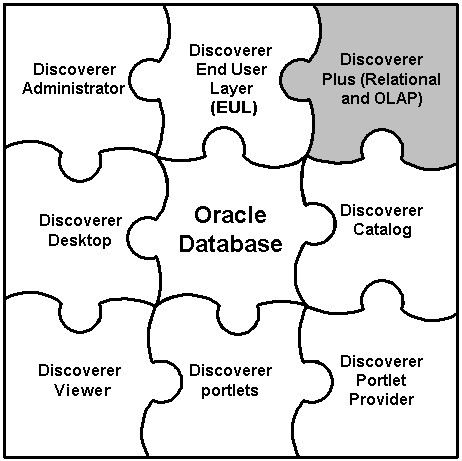
Other Discoverer users can open the worksheets you share with them, using Discoverer Plus Relational, Discoverer Viewer, Discoverer portals, and Discoverer Desktop.
A relational data source is a database in which information is stored in a number of database tables. Each database table comprises a number of columns, and one or more rows. The different tables in a database can be related. Having data in separate but related tables is an efficient way to store and retrieve information.
The example above shows three database tables:
the STORE table contains three columns:
Store_key
City
Region
the PRODUCT table contains three columns:
Product key
Description
Brand
the SALES_FACT table contains five columns:
Store_key
Product_key
Sales
Cost
Profit
Relational databases are a widely used data source. However, relational databases can become complicated when they contain hundreds of related tables, with thousands of columns, and millions of rows. Finding information in such a database can be a real challenge.
The Discoverer manager uses the Discoverer End User Layer to hide the complexity of the database from you. By defining business areas, folders, and items, the Discoverer manager enables you to use Discoverer Plus Relational to find just the data you want to analyze.
A business area is a collection of related information in the database.
The Discoverer manager works with the different departments in your organization to identify the information that each department requires from the database. The Discoverer manager locates the information in the database and groups it into business areas. Within each business area, the Discoverer manager organizes information into folders.
For example, the key areas of a company's business might be sales, production, and human resources. So the Discoverer manager might create three corresponding business areas.
Figure 2-3 Three Discoverer business areas
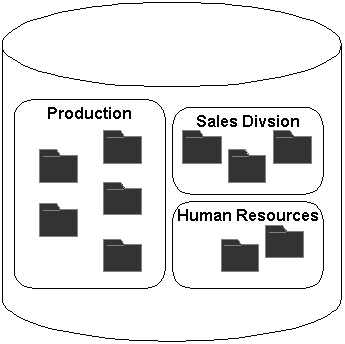
The Discoverer manager also decides which users can access which business areas.
The figure below shows how business areas are displayed in Discoverer Plus Relational. The business areas in this example are called Video Store Tutorial, and NewBusinessArea1.
A folder is a collection of closely related information. For example, information about products that your company produces might be in a folder called Products.
If you are familiar with relational databases, a folder is similar to a database table or view. Indeed, a folder can be based directly on a database table or view.
The different folders in a business area might contain related information. For example, a business area might contain two folders:
a Products folder containing information about each product (e.g. product ID, product description, product brand
a Sales folder containing information about the sales of each product (e.g. the store where a particular product was sold, the price for which the product was sold, the cost of the product, the profit made on each sale, and the product reference number)
Figure 2-5 A business area containing two folders
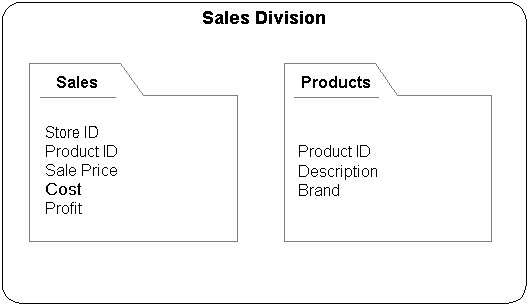
By querying the Sales folder, you can see information about a particular sales transaction. But to see the description of the product that was sold (rather than simply the product reference number) you also need to query the Products folder.
The Discoverer manager might combine information from several folders into one folder to make it easy to find all the information you need. For example, the Discoverer manager might create a third folder called Product Sales Info, containing the description of each product sold (from the Products folder) and the price that was paid for it (from the Sales folder).
Figure 2-6 A Discoverer folder containing information from a Products folder and a Sales folder
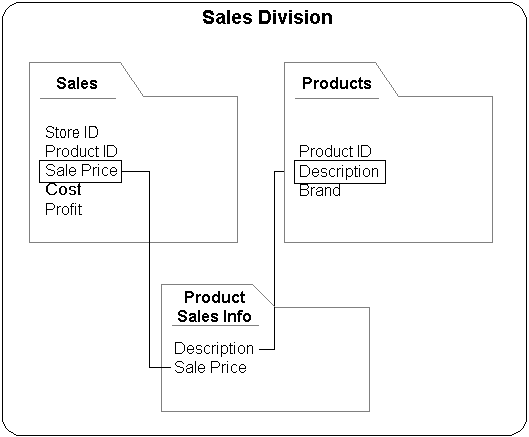
The figure below shows how folders (e.g. Video Analysis Information, Stores and Sales Details, Monthly Sales Analysis) are displayed in Discoverer Plus Relational's item navigator tab.
Items are different types of information within a folder.
If you are familiar with relational databases, an item is similar to a column in a database table. Indeed, an item might be based on a column in a database table.
For example, each product your company produces might have a reference number, a description, and a brand. The Products folder containing information about these products will have three items (a Product Reference Number item, a Description item, and a Brand item).
Figure 2-8 A Discoverer folder containing three items
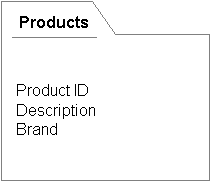
Each item contains individual pieces of information. For example, the reference number item might contain a list of reference numbers.
The Discoverer manager decides which items are included in folders based on the information that you want to analyze.
The figure below shows how items (e.g. Department, Region, City) are displayed in Discoverer Plus Relational's item navigator tab.
Discoverer is supplied with a sample database containing data about a fictitious company called Video Stores. Information in the Video Stores sample database includes:
sales region
year
department
sum of profit
size of store (in square metres)
type of store design (e.g. compact, modern, or traditional)
store name
Discoverer is also supplied with a sample workbook called Video Tutorial Workbook that you can use to analyze the example data. The Video Tutorial Workbook contains a number of worksheets, including:
a table worksheet called Tabular Layout
a crosstab worksheet called Crosstab Layout
Note: The Discoverer manager might have given the sample workbook a different name from Video Tutorial Workbook.
Both worksheets enable you to analyze the sales and profitability of Video Stores (see figure below).
Figure 2-10 Sample Discoverer worksheets in the Video Tutorial Workbook
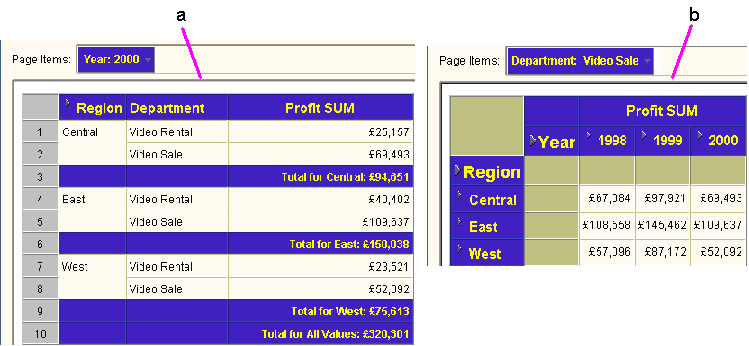
Discoverer Plus Version 10.1.2. contains the following new and improved features:
Native support of the database OLAP option. You can now analyze multidimensional databases (for more information, see "Using Discoverer Plus with a multidimensional data source").
Enhanced interactivity. You can now drag and drop directly in the Discoverer workarea, and also use right click menus on items and values, new toolbars, and a graphical date selector (for more information, see " About the Discoverer Plus Relational work area").
Conditional formatting. You can now create conditional formats (also known as exception formats) and stoplight formats (for more information, see "What is conditional formatting?").
Enhanced drilling. You can now drill directly into graph data, and create dynamic links to other Discoverer worksheets or Internet URLs (for more information, see "About drilling in Discoverer worksheets").
Enhanced printing. You can now perform advanced page setup, print preview, and print to PDF format operations (for more information, see "Printing worksheets and graphs").
New export formats. You can now export to Excel Web Query (*.iqy) format to run queries in Microsoft Excel sheets, and export to PDF format (for more information, see "Printing worksheets and graphs").
Enhanced workbook management. You can now select workbooks from a new workbook list that has improved support for large numbers of users (for more information, see "Using workbooks and worksheets").
New portlet types. You can now add a Gauges portlet (to represent data as a gauge) and a List of Worksheets portlet (which replaces the List of Workbooks portlet in previous releases) to Oracle Portal pages (for more information, see "Publishing worksheets in OracleAS Portal").
Single Sign-On support for Virtual Private Databases. Depending on how Discoverer has been set up, you can now access data in a Virtual Private Database using a Single Sign-On ID (for more information, see "How do I know what Single Sign-on ID is being used in Discoverer Plus?").
Enhanced worksheet formatting. You can now create worksheet text areas, and use new worksheet formatting options (for more information, see "Using workbooks and worksheets" and "Editing worksheets and worksheet items").
Enhanced workbook scheduling. You can now share scheduled workbook results with other Discoverer users (for more information, see "Sharing workbooks").
Enhanced parameter handling. You can now select parameters using cascading Lists of Values (LOVs) and parameter index values, and parameters are marked as mandatory or optional, (for more information, see "Using parameters").
Enhanced charting. You can now select from new graph types and predefined graph styles, and use drill functionality in graphs (for more information, see "Creating graphs in Discoverer").
To find out more about Discoverer Plus Relational, use:
the Discoverer Plus Relational help system
The Discoverer Plus Relational help system gives you context sensitive access to reference information from the Oracle Business Intelligence Discoverer Plus User's Guide.
Click the Help button or press F1 in any Discoverer Plus Relational dialog to display context sensitive help, or choose Help | Help Topics to see a list of the topics in the help system.
To find a topic in the help system:
use the Contents tab to see a structured list of the topics in the help system
use the Index tab to search the help system using pre-defined keywords and phrases
use the Search tab to search the help system for keywords and phrase s that you define
the Oracle Business Intelligence Discoverer Plus User's Guide
The Oracle Business Intelligence Discoverer Plus User's Guide is available in html and PDF format on:
the Oracle Application Server Documentation CD
the Oracle Technology Network at www.oracle.com/technology
Oracle Technology Network
Other information about Discoverer Plus (e.g. white papers, best practices) is available from Oracle Technology Network at www.oracle.com/technology.